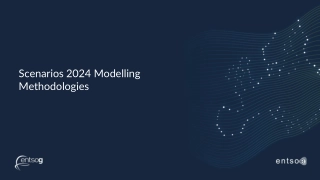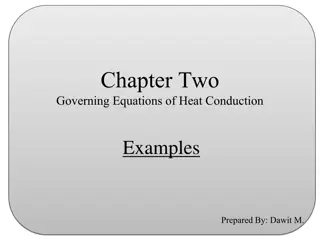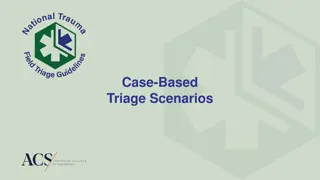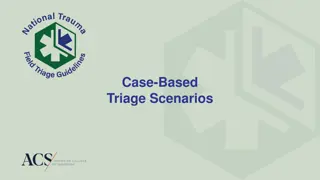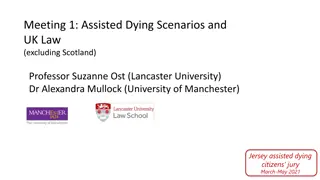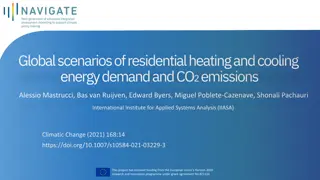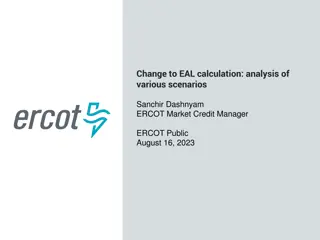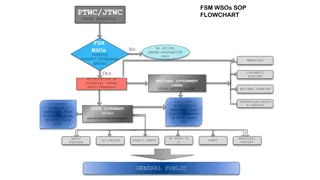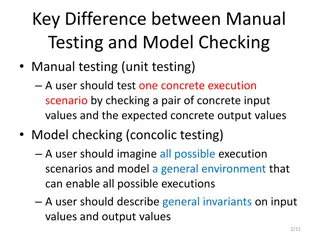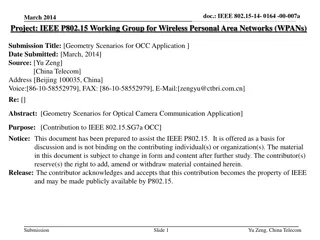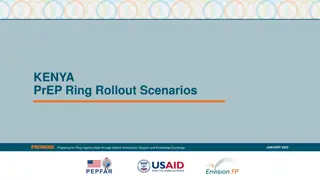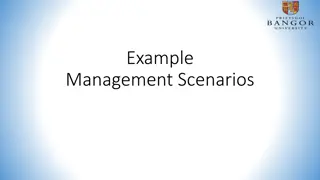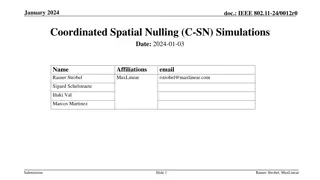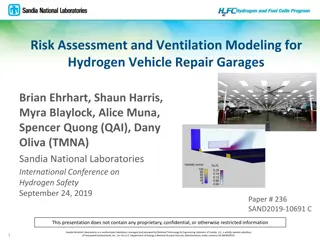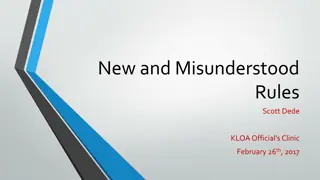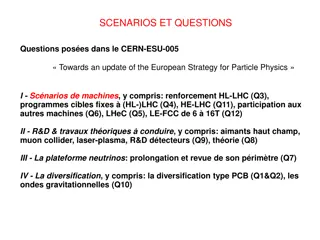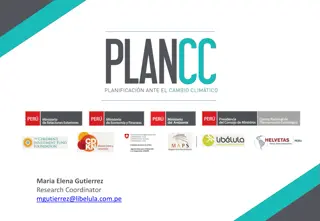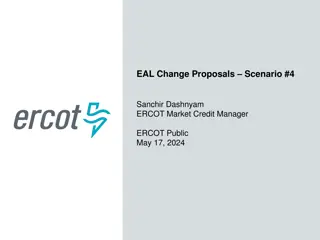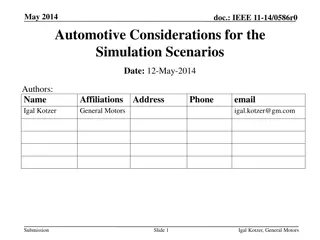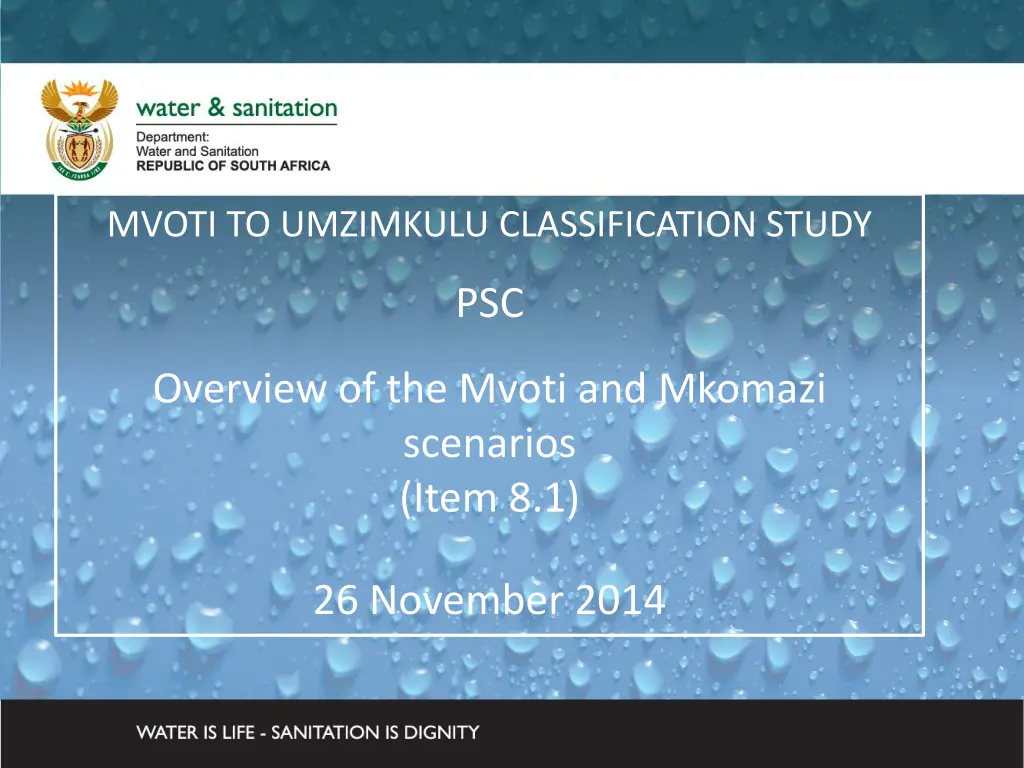
Understanding Water Resource Scenarios for Effective Management
Discover the importance of scenarios in water resource management, including ecological evaluations and multi-criteria analysis. Learn how these scenarios are used to evaluate, classify, and recommend water resource management strategies for sustainable outcomes.
Download Presentation

Please find below an Image/Link to download the presentation.
The content on the website is provided AS IS for your information and personal use only. It may not be sold, licensed, or shared on other websites without obtaining consent from the author. If you encounter any issues during the download, it is possible that the publisher has removed the file from their server.
You are allowed to download the files provided on this website for personal or commercial use, subject to the condition that they are used lawfully. All files are the property of their respective owners.
The content on the website is provided AS IS for your information and personal use only. It may not be sold, licensed, or shared on other websites without obtaining consent from the author.
E N D
Presentation Transcript
MVOTI TO UMZIMKULU CLASSIFICATION STUDY DWA CORPORATE IDENTITY Presented by: Johan Maree Deputy Director: Media Production Overview of the Mvoti and Mkomazi scenarios (Item 8.1) PSC 12 December 2012 26 November 2014
Mvoti Study integrated steps 1: Delineate units of analysis and describe the status quo 2: Initiation of stakeholder process and catchment visioning 3: Quantify EWRs 4: Identification and evaluation of scenarios within IWRM 5: Draft Management Classes 6: Resource Quality Objectives (EcoSpecs & water quality (user)) 7: Gazette class configuration Scenario Evaluation, MC determination 2
What are scenarios? Scenarios, in context of water resource management and planning are plausible definitions (settings) of the factors (variables) that influence the water balance and water quality in a catchment and the system as a whole
What needs to be evaluated? Degree of the ecological health defined by Ecological Categories of biophysical nodes (none-monetary) Ecosystem Services (none-monetary) Socio-Economic implications Monetary (GDP) and non-monetary (job count)
How is it rated? Ecological consequences are rated according to the degree that the Recommended Ecological Category is met. (REC is the top of the scale.) Ecosystem Services, present state is 1.0 with relative rating for scenarios. Economic Indicator, in general GDP or other relevant comparative monitory indicator. Employment, number of jobs as affected by scenario. Integrated rank, weighted scores of above 4 variables two methods of ranking.
What are scenarios used for? Different levels of water use and protection are evaluated with the aim to find a preferred balanced scenario. Water Resource Classification is the process to evaluate and recommend what that balance scenario entails.
Why Multi-Criteria Analysis? Method to compare alternatives where the outcomes (consequences) are in different numerical terms. Ecological consequences is a relative rating while economy is in monetary terms and employment in numbers. Multi-Criteria Analysis is appropriate in these circumstances.
Integrated Comparison Concept of Multi Criteria evaluation method For all scenarios Ranked Ranked SC for IUA / system SC for each reach / node Ecology Weighting process Score Fish Inverts Phys, Chem Degree of meeting REC Rip veg Geom (all variables) EGSA Weighting process Score Food, fuel Relative to present provisions Cultural Regulating Economy Weighting process Score Household Income GDP Jobs Relative to base condition
Deriving the Management Class EC C D D C C C C D B D C C/D C River Reach B81A-00242 B81A-00256 B81A-00263 B81A-00270 B81B-00233 B81B-00234 B81B-00246 B81B-00251 B81B-00269 B81B-00227 B81B-00240 B81B-00247 EWR1 Total length Length (km) Ecological Categories for a Selected Scenario (IUA 1) 21.9 5.3 5.1 20.2 3.2 7.1 14.7 3.7 6.5 11.0 10.2 12.5 25.7 147.1 Pd = ?? Total length Pc = ?? Total length Pb = ?? Total length Pa/b = ?/?? Total length Management Class Criteria Prominent EC % EC representation at units represented by biophysical nodes in an IUA A/B 0 B 60 C 80 D 95 < D 5 A & B EC C EC D EC Class I Class II 0 70 90 10 Either 0 80 20 Class III Or 100 Management Class: I, II or III EC - Ecological Category
DWA CORPORATE IDENTITY Presented by: Johan Maree Deputy Director: Media Production Description of Scenarios 12 December 2012 Mvoti River System uMkomazi River System
Mvoti River Catchment Mvoti River Catchment Storage Regulation Low River Abstractions reduced base flows River management restrict u/s to maintain supply to KwaDukuza (Stanger) Future resource development IsiThundu Dam Imvutshane Dam 11
Water Requirements Present Day Scenario defined from: Water Reconciliation Strategy Study for the KwaZulu-Natal Coastal Metropolitan Areas. DWA All Towns Strategies and the Water Reconciliation Strategy Study for the Kwazulu Natal Coastal Metropolitan Areas. Ultimate Development Scenario: Increased water use and return flows for: Greytown Long term option - groundwater abstraction, baseflow adjusted, return flows increased. KwaDukuza - Return flows increased (u/s estuary). Abstraction from the proposed Imvutshane Dam being planned by Umgeni Water, supply to Mapumulo and Maqumbi. Abstractions from the proposed Isithundu Dam for supply to North Coast and KwaDukuza areas.
Mvoti River Catchment Scenario Variables Scenarios Ultimate Development Demands & Return Flows (2040) EWR Isithundu Dam Imvutshane Dam MV1 (PD) No No No No MV3 Yes No Yes Yes MV41 Yes REC total Yes Yes MV42 Yes REC low Yes Yes MV43 Yes REC low+ Yes Yes Notes: Recommended Ecological Category (REC) is to maintain the Present Ecological State (PES). Therefore no reduction in current water use activities needed to achieve REC. Imvutshane Dam : Applied release recommendation in licence application from REC total = Total EWR to meet REC requirements released from proposed Isithundu Dam. REC low = Only release low flow component of REC. REC low+ = Release low flow component of REC and Total Flows for January, February and March.
Water available from future developments Abstraction (million m3/annum) Scenarios EWR IsiThundu Dam (Historical Firm Yield) Imvutshane Dam MV1 (PD) Not applicable, no development in place. No 34.9 MV3 No 8.1 MV41 REC total 4.38 15.2 MV42 REC low 13.8 MV43 REC low+
uMkhomazi River Catchment Mzinto uMkhomazi River None EJ Smith Storage Regulation Low Sezela Dam Future resource development (uMkomazi Water Project- Smithfield Dam, Ngwadini Off- channel storage) 15
Water Requirements Present Day Scenario defined from: Mkomazi Feasibility Study (2008 development level) Revised high resolution hydrology was developed. Ultimate Development Scenario: Mkomazi Feasibility Study - 2040 scenario. Abstractions from Smithfield and Ngwadini off-channel storage dams Year Water Use Sector (In-catchment) 2008 61.36 6.37 37.70 2.86 53.00 161.29 2040 72.71 6.37 51.69 3.03 57.44 191.24 Afforestation Invasive Alien Plants Irrigation Stock water Urban/Industrial Total: (Values in million m3/annum)
uMkhomazi River (1 of 2) Scenario Variables Scenarios (MK) Ultimate Development (2040) EWR Smithfield Dam Ngwadini OCD 1 2 No Yes No No No Yes No Yes * REC tot (EWR 2) 21 Yes Yes Yes * REC low (EWR 2) 22 Yes Yes Yes * REC low+ (EWR 2) 23 Yes Yes Yes * REC tot (EWR 3) 31 Yes Yes Yes * REC low (EWR 3) 32 Yes Yes Yes * REC low+ (EWR 3) 33 Yes Yes Yes * * River abstraction to Ngwadini Dam not supported by Smithfield Dam, abstract HFY. (EWR 2) = Releases made from Smithfield Dam based on EWR site 2 requirements. (EWR 3) = Releases made from Smithfield Dam based on EWR site 3 requirements. Scenario 2x, 3x and 4x, releases are made for d/s users from Smithfield Dam with 10% losses. Mainstream irrigation maintained a present reliability of supply.
uMkhomazi River (2 of 2) Scenario Variables Scenarios (MK) Ultimate Development (2040) Yes Smithfield Dam EWR Ngwadini OCD 4 No Yes Yes (with support) REC tot (EWR 2) REC low (EWR 2) 41 42 Yes Yes Yes Yes Yes (with support) Yes (with support) Notes: (EWR 2) = Releases made from Smithfield Dam based on EWR site 2 requirements. with support = Ngwadini Dam supported from Smithfield Dam to supply 54.8 million m3/a. Scenario 4x, EWR requirements maintained in river reach d/s of offtake to Ngwadini Dam. General notes: Sappi SAICCOR is supplied with EWR releases. All scenarios maintain a minimum flow of 1 m3/s into the estuary. REC total = Total EWR to meet REC requirements released from proposed IsiThundu Dam. REC low = Only release low flow component of REC. REC low+ = Release low flow component of REC and Total Flows for January, February and March.
Water available from future developments Scenario Variables Scenarios (MK) Ultimate Development (2040) No Yes Smithfield Dam Ngwadini Off-Channel Dam EWR Total 1 2 No No 196.0 12.0 208.0 142.2 8.0 REC tot (EWR 2) 21 Yes 150.2 150.6 8.0 REC low (EWR 2) 22 Yes 158.6 150.6 8.0 REC low+ (EWR 2) 23 Yes 158.6 150.1 6.0 REC tot (EWR 3) 31 Yes 156.1 161.0 6.6 REC low (EWR 3) 32 Yes 167.6 161.0 6.6 REC low+ (EWR 3) 33 Yes 167.6 197.3 142.5 54.8 4 Yes No 84.1 54.8 REC tot 41 Yes (EWR 2) 138.9 92.5 54.8 REC low 42 Yes (EWR 2) 147.3
Ultimate Wastewater Discharge Scenarios Two possible options were put forward by eThekwini: Scenario 21b: Discharge of 20 Ml/day into the estuary catering for future developments in the catchments with General Standard nutrient removal. Additional 30 Ml/day to be transferred from the Kingsburgh Works.
DWA CORPORATE IDENTITY Presented by: Johan Maree Deputy Director: Media Production End Overview and Scenarios 12 December 2012

